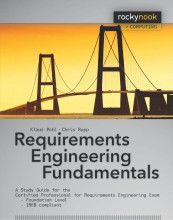Eliciting Requirements - Elicitation Techniques
7 important questions on Eliciting Requirements - Elicitation Techniques
What factors influence the choice of elicitation techniques?
- time and budget constraints, as well as the availability of the stakeholders
- the experience of the requirements engineer with particular technique
- the chances and risks of the project
What are the elicition techniques available?
- Surveytechniques (e.g.interviews,questionnaires)
- Creativitytechniques (e.g.brainstorming, brainstorming paradox, change of perspective, analogy technique)
- Document-centric techniques (e.g. system archaeology, perspective-based reading, requirements reuse)
- Observation techniques (e.g. field observation, apprenticing)
- Support techniques (e.g. mind mapping, workshops, CRC cards, audio and video recordings, use case modeling, prototypes)
Describe the survey technique?
- Good for eliciting explicit knowledge (satisfiers, performance factors):
- interview, questionaires
- Higher grades + faster learning
- Never study anything twice
- 100% sure, 100% understanding
Describe the creativity technique?
Advantage: Good for eliciting excitement factors. (delighters, unconcious requirements).
Disadvantage: Creative techniques are not suitable for specific functions about system behavior.
- brainstorming
- brainstorming paradox (what can go wrong)
- change of perspective
- analogy technique (how other branche fix it)
Describe the document-centric technique?
Three options:
- system archaeology
- perspective-based reading
- requirements reuse
Describe the observation technique?
Well suited to elicit detailed requirements and dissatisfiers; is not suited for the development of new processes.
- Advantage: to be used if the domain specialists are not available or only for a short time.The requirements engineer observes the stake brochure.
- Requirements engineer observes and documents the system and the processes that the system must be able to handle. Just like potential risks and errors.
Describe support technique?
- mind mapping
- workshops
- CRC cards (Class responsibility Collaboration)
- audio and video recordings
- use case modeling
- prototypes
The question on the page originate from the summary of the following study material:
- A unique study and practice tool
- Never study anything twice again
- Get the grades you hope for
- 100% sure, 100% understanding
































